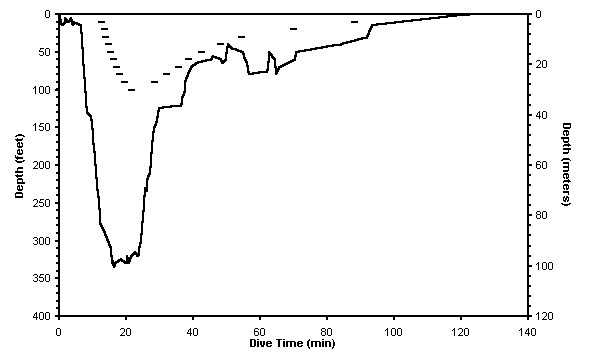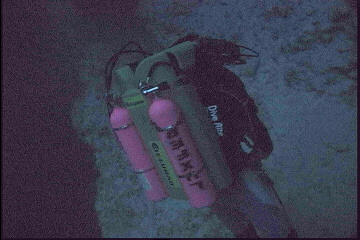
Solid line indicates depth, dashes ("-") indicate decompression ceilings, bar ("|") represents cleared to surface.
Daily Log Report for Submitted by Richard Pyle |
| This morning I met with Theo Isamu, of the Division of Marine Resources in Palau, to discuss the terms of our fish collecting permits. He decided to cut the number of specimens I was allowed to collect in half, but this still allows us opportunity to collect many new species. After lunch, we loaded the boat with rebreathers and departed for yet another dive at Augulpelu Reef. Weather conditions were excellent today. |
| Dive Number 1 of 1 |
| Divers: | Richard Pyle, John Earle, Ken Corben |
 Solid line indicates depth, dashes ("-") indicate decompression ceilings, bar ("|") represents cleared to surface. |
| Max. Depth: 330 feet (100 meters) | Time: 3:48pm | Duration: 2 hr, 02 min |
| Location: | Augulpelu Reef; E side of reef; "DeGruy Debris" (07 16.41' N, 134 31.44' E) |
| Marine Life: | Many interesting fishes down deep. I collected one Holanthias borbonius (a beautiful species of fish not previously recorded from Palau), and a small damselfish of the genus Chromis, which appears to be new. I saw at least two different species of Liopropoma, and several other wrasses and gobies (including a rare deepwater wrasse of the genus Bodianus). John saw some interesting fishes as well, but because we didn't bring lights on this dive, we were limited in what we could collect. |
| Remarks: | There were two thermoclines during the
descent; one at about 130 feet, and the other at about
280 feet. Below 280 feet, we estimate that the water
temperature was in the low 60's (tomorrow we'll bring a
thermometer). John stopped at about 300 feet, and I
worked a bit below him. The reef profile started with a
vertical drop from about 10 feet to about 140 feet, then
a slope to 180 feet, then a sheer cliff to 280 feet, a
terrace that slopes to 300, then another cliff that
disappeared into blackness below. At the top of the deep
drop, there were many small ledges and caves with a
variety of fishes The photo at left shows John Earle cruising
along the top of the deep drop-off at a depth of 300 feet
(no, it's not rotated 90 degrees - this is a shot looking
down on John from above; the dark region on the left is
the vertical drop to the abyss). It was taken with
available light, yet the pink cylinders are clearly pink;
which I find to be remarkable. The photo at left shows John Earle cruising
along the top of the deep drop-off at a depth of 300 feet
(no, it's not rotated 90 degrees - this is a shot looking
down on John from above; the dark region on the left is
the vertical drop to the abyss). It was taken with
available light, yet the pink cylinders are clearly pink;
which I find to be remarkable.
Tomorrow we have two dives planned: the first will be at the same spot we went to today, and the second dive will be shallower to watch and film as a team from the Waikiki Aquarium brings a trap full of Nautilus back to the surface. |
| Disclaimer: Several aspects of the dive profile(s) illustrated above deviate from conventional wisdom regarding appropriate decompression procedures. The dives referred to on these web pages are of an experimental nature, and all persons involved with these dives are fully cognizant of the associated risks. The decompression practices followed on these dives are derived from published information, in conjunction with the many years of extensive experience of the divers involved. These practices have not been tested under controlled conditions, and may not work equally well for all divers. Kids, don't try this at home!! |
![]() These daily reports made
possible through the generous support of Toshiba America.
These daily reports made
possible through the generous support of Toshiba America.
| Previous Day | Next Day |
Return to the Palau 'Twilight Zone' expedition home page.
|
| Copyright 1997, by Bishop Museum. All rights reserved. All media are for the personal use of students, scholars and the public. Any commercial use or publication of them is strictly prohibited. |